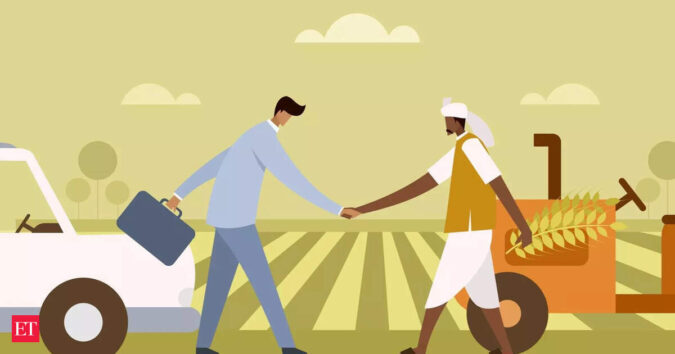Rural has outpaced urban demand by far
Rural India has remained the strongest driver of FMCG demand, clocking higher volume growth than urban markets for seven straight quarters. In the September quarter, rural volume grew 5.7%, far ahead of the 1.9% rise in cities. Though the gap is narrowing compared to last year, rural markets still hold the edge, as per NielsenIQ data.
Overall FMCG value growth stood at 12.9%, supported by price increases and a steady revival in smaller towns. Food and personal care categories grew 5.4%, while modern trade continued its recovery with 4.2% growth. A rapid expansion of small manufacturers, along with easing disruptions from GST-linked issues flagged by companies like HUL, Dabur, and Godrej, has also helped improve consumption trends in both rural and semi-urban pockets.
The data suggests that while urban demand is gradually picking up, rural India remains the backbone of the FMCG recovery story. The urban market, which forms the bulk of fast-moving consumer goods (FMCG) demand, is recovering moderately, particularly in smaller towns. Sequentially, it experienced a slowdown. Rural market, which is of small packets, is driven by affordability, accounts for around 38 per cent of the FMCG demand.


As per the Morgan Stanley report, a number of headwinds have weighed on urban demand, such as tighter monetary policy (real rates averaged 1.55% in 2024); a weaker job market (Naukri job index declined 1.3% in 2024); and
slower wage growth (BSE 500 employee expense grew 6.6% in 2024). Meanwhile, rural demand was supported by favourable agriculture incomes, driven by buoyant crop output. However, a pivot in monetary and fiscal policy stance is supporting a revival in urban demand, as reflected in recent high-frequency data, such as auto sales growing 25% in the festive period.
Why urban demand will recover
Morgan Stanley anticipates a continued recovery in urban demand as well as support from rural demand in the next 12 months. Several factors will contribute to this trend.
The RBI has loosened its grip on monetary policy since early 2025, across rates, liquidity, and macroprudential regulations, to ensure eased financial conditions. This is likely to push retail lending higher, by lowering borrowing costs, and thus support a cyclical recovery in urban demand, the report says. Thus far, following the 100bps of rate easing, the transmission of eased policy rates from February-August 2025 has been 106bps on weighted average deposit rates (WADR) and 58bps on weighted average lending rates (WALR).
Another urban demand driver would be fiscal push through tax rates. The government has undertaken both direct and indirect tax reforms in an attempt to boost household disposable income. The accumulated savings, arising from income tax cuts (worth Rs1tn) announced in the F2026 Budget, along with GST rate rationalisation, are likely to significantly spur discretionary consumption, particularly among the middle class, says the report. The second-order impact of improving business sentiment appears likely to encourage private sector investment activity, which bodes well for the labour market outlook, it says.
Moderating inflation is improving real wages. The report says that the softening trend in inflation, alongside the anchoring of inflation expectations, has facilitated greater purchasing power for both the rural and urban consumer, by improving real wages, and thus commensurately provided a fillip to consumption levels.
The Morgan Stanley report sees jobs momentum also driving urban demand. The labour market data is indicative of a pickup in momentum in hiring activity. The Naukri Job index (proxy for organised sector hiring) has shown a recovery, up 3.7% YoY on a CYTD25 basis, vs. -1.3% in CY24. The steady upturn in employment implies higher income levels, which in turn supports consumer spending. Moreover, the employment demand under MGNREGS has been consistently moderating and normalizing close to pre-pandemic trends, which supports the narrative of improving employment opportunities.
The terms of reference and the committee for the 8th Central Pay Commission was announced last month, with recommendations expected within 18 months of the date of its constitution. The revised pay scales and arrears will be retrospective in nature, applying from January 1, 2026. The arrears/payouts for the months between January 2026 and the date of actual month of implementation will be paid once the new pay scales are approved. The report says while the impact on consumption will be seen only once payout starts (given considerable uncertainty about the quantum of hike), the adjustment of salaries of central government employees (~4.7mn employees and 6mn pensioners) is likely to provide a meaningful near-term boost to consumption.
Rural demand too will remain healthy
In 2024, overall consumption was steered primarily by rural demand, buoyed by favourable weather conditions that ensured record summer and winter crop output at 354mn tonnes (up 6.5% YoY). The resilience in summer crop sowing has continued in 2025 amid surplus rainfall (108% of LPA), which also led to healthy reservoir levels and soil moisture conditions, which augurs well for the ongoing winter crop sowing and yields, the report says. Moreover, lower inflation improves real rural wages and purchasing power and also improves the rural terms of trade. Indeed, growth in real rural wages is tracking at 3.1% in CYTD25 vs. 1% in CY24.
The confluence of these tailwinds is likely to ensure that farm incomes remain supported, and as such rural demand remains resilient, the report says. The latest edition of the RBI’s Rural Consumer Confidence Survey highlights improving current and one-year forward perceptions at an aggregate level, driven by a promising employment outlook, softening inflation, and thus higher income levels. Therefore, following the combined impact of these aforementioned drivers, urban demand is reflecting nascent signs of pickup, which is further buoyed with the ongoing festive and wedding season.
